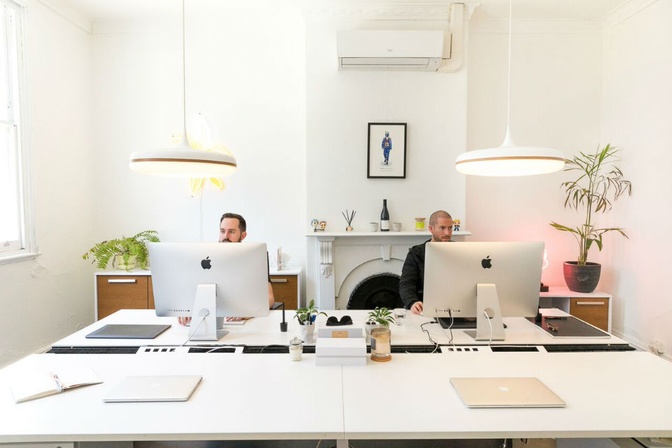Client hungry? Here’s how to lock in those tenders.

Australia’s creative industry is thriving, and anyone running their own studio or agency will no doubt be aware of the ongoing battle to secure projects and clients. The healthy pool of creative talent makes for a healthy scene; but it also means standing out between smaller and larger corporate agencies can be taxing.
So, how do you find your niche as business in such a competitive field? Some focus on a single aspect of the trade, like branding or digital. While others’ portfolios covers everything from photography to UX.
Speaking to Niika managing director Mark Lipert about his Melbourne-based boutique studio, we find out what it takes to stay afloat while managing a small business in a saturated industry.
While having a master of the creative process in your team is one of the cornerstones for success, so is having someone that’s business savvy. Niika is a team of just four who each play a valuable and unique role in keeping their consistent flow of clients happy.
“No matter how good your work is, it’s only one aspect of running a successful agency. It’s important to have someone dedicated to finding work, looking after your clients, pricing projects and writing proposals, as well as potentially assisting with some project management.”
Lipert believes identifying the right skill sets in those who you work with will ultimately improve trade, provided the entire team is included in the business’s core goals.
Niika’s success so far can be attributed to its team sharing the same ambitious common ground. Making sure the designer, developer and account manager are on the same page makes for productive relationships in the office, and a healthy relationship between studio and client.
“It really comes down to communication between everyone involved and understanding not only what the client wants, but what their brand needs – which can occasionally be two separate things.”
There’s more to it than having four switched on creatives in one room, though. Strategy plays a part in longevity, and Lipert states this is something often forgotten – especially in the early stages.
“When you start, all you care about is getting the work and getting it done, but it is also important to consider how that work gets done.
‘What is the client experience?’, ‘How do you write a proposal?’, ‘How much, and when, do you charge?’, ‘What happens if the client isn’t happy with your first 27 logo revisions?’ These are all questions he and other studios face.
There’s a fine line between keeping the client happy and retaining a steady flow of revenue, and Lipert has seen numerous agencies go under by failing to find the balance. It’s a matter of taking pride in the work produced and charging appropriately in terms of quality and time.
While the Niika team is ambitious to grow and progress, its also aware of its capabilities in taking on the right amount of work – something Lipert sees as a danger zone for inexperienced agencies.
“It’s about refining processes, delivering the best work you can and making sure your communication and service is reflective of where you want to be. A lot of agencies fail because they grow too quickly and they aren’t able to take care of their clients in the same way as they could when they were smaller.”
The term ‘creative agency’ can mean many different things in today’s climate, and even though the temptation to offer services in every creative facet may be strong, Niika has proved refining a few of these initially will provide stronger foundations as the business grows.
“It does seem like it’s more valuable to be known for doing a few things very well as opposed to being a jack of all trades,” says Lipert.
“When we talk to people we generally describe ourselves as being experts in creative and website development specifically, those are the two areas that we want to known for. Everything else we offer is really just to add value and convenience to our clients’ lives.”
This rings all too true when delving into Niika’s portfolio. After tendering for the annual Beyond the Valley creative several years ago, a generous portion of its year is taken up producing everything from the festival’s website, print and digital collateral, and even aspects of the stage design; it’s about identifying how you can add value, and then capitalising on it.
While producing Beyond the Valley’s creative for the past three years, Niika has also identified a niche in the entertainment industry and have since been honing their craft accordingly. Today, the agency of four is often approached by potential clients who have spotted its work on other events. Now working across festivals both locally and abroad, the team sees the importance in studios finding a specific focus and building on that strength.
“Once you are proven in a certain industry you do have more credibility, which does make it easier to find more of the same work,” Lipert says.

While having a sleek online folio may see some new clients call you as you wait by the studio phone, Lipert holds the firm belief both junior and mature agencies should be out in the field seeking fresh clients.
“Make sure you talk to people, and if you’re really new do a bit of networking, but most importantly become aware of identifying opportunities in your day-to-day.”
This requires extra hours outside of the 9–5, just as client retention does once you’ve locked in a new project, and Lipert follows at least a few rules in doing so:
“Check in from time to time. If you’ve done a really great job the first time around with minimum fuss, chances are you’ll be warned before if they’re thinking of leaving you.”
“Be honest and nice, and if the two are in conflict, be honest.”
Photography: Alexander Sproule-Lagos



